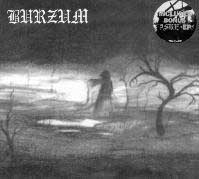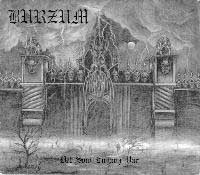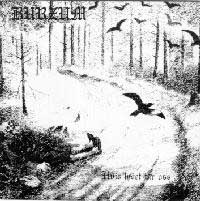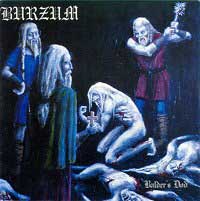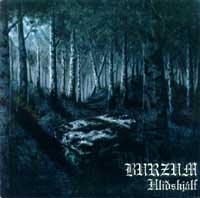Burzum
 In a search for what black metal would become it became necessary to find out what it meant, and that leads us to a category of black metal bands who are "the conceptualizers," most notably, Burzum, Darkthrone and Immortal. However, it is only Burzum who exceeded the epic with the majestic in terrifyingly abstract and emotional music. In a search for what black metal would become it became necessary to find out what it meant, and that leads us to a category of black metal bands who are "the conceptualizers," most notably, Burzum, Darkthrone and Immortal. However, it is only Burzum who exceeded the epic with the majestic in terrifyingly abstract and emotional music.
Created to "stimulate the fantasy of mortals," the music of Burzum is vengeance of chaos against the propagation of administrative and technological models for human existence, ideas which demand allegiance to rules and "morality," or the wisdom of mercy and social compromise as seen by Judeo-Christian technocratic society. Thrusting his fist in the face of that evident death-worship, Grishnack enfolds the rejected darkness in the lucidity of structure in the most forebodingly empty and threatening views of the world.
Total nihilism reduces its belief in inherent nothing to nothingness and from that builds to absolutist ideologies which avoid the emptines discovered; Burzum carries this passion in music and lyrics as well as artistic conception and presentation. The includes the darkly organic Pagan neo-Nazi post-Nietzschean philosophies which Varg spouts in fragments to a barely credible and barely listening press. He envisions his ideology and music as a continuation of Nazi Germany in the 1940s as a pagan revolution against Jewish and Christian (Judeo-Christian, including Islam) influence, notably "morality," against which not only Nietzsche but other influential thinkers have railed (Burroughs, Schopenhauer, Wittgenstein, Pound, Shaw).
 While unorthodox to the tastes of the public, these political beliefs must be understood for the complex ideological system they express at the approach of the demise of a materialist civilization. In postmodernist thought, we learned that our society operates with a justified "text" of ostensible motivation, and a submlimated "subtext" of desires and natural passions. As society continues to crumble toward moralism in the midst of self-destruction, newer thinkers look away from Judeo-Christianity and Liberalism toward older modes of thought which valued the place of all of humanity in nature before the "moral worth" of the individual. While unorthodox to the tastes of the public, these political beliefs must be understood for the complex ideological system they express at the approach of the demise of a materialist civilization. In postmodernist thought, we learned that our society operates with a justified "text" of ostensible motivation, and a submlimated "subtext" of desires and natural passions. As society continues to crumble toward moralism in the midst of self-destruction, newer thinkers look away from Judeo-Christianity and Liberalism toward older modes of thought which valued the place of all of humanity in nature before the "moral worth" of the individual.
For more information on the Judeo-Christian basis to materialist civilization in the twentieth century, read Friedrich Nietzsche's "Genealogy of Morals," sections 7-10 (describes the virus of Judaism and Christianity as a cult of psychological dependency and need, resulting in sublimated sado-masochistic power-obedience behavior) or Vaclav Havel's "Power of the Powerless." Also, to understand Vikernes, it is useful to study Northern European culture in its origins from Asia to India, and its history as an independent and noble community that used naturalistic values for the basis of its social structure, in dramatic opposition to the materialist culture to come with the rise of Jewish and Christian immigrants to Europe.
Long before the first Christian appeared in a misty fjord, the Norwegian people had a socialist approach to family, an open and fearless society, a hierarchy of metaphorically symbolic gods, and a world-exploring culture. Their trading partners were mutually considered equals, and their women had more freedom than in any other society on earth. Their values reflected the least of Nietzschean "clever" or "lower" materialist values and the highest of materialist-transcendent "noble" or "warrior" values. During the occupation, Northern Europeans have modified capitalism/socialism and Christianity to their most benevolent forms ever while maintaining one of the nicest places to live in the world with the least hypocritical and vengeful moralistic influence of the civilized nations. European society has suffered its 1,000 years of Christianity and as pro-Judeo-Christian influences in politics and media build in America and the island England, desire for separatism and neutrality is on the rise.
As a result, Burzum stays controversial: not answered, not rebutted, not forgotten and not even carried on. This work is simply enduring as both music and ideological impact of emotion and action.
Burzum/Aske
Misanthropy
|
1991
|
|
|
Production: Reasonable, warm garage organic production.
Review: Early black metal from Count Grishnack defines some of the characteristics of the genre in a lengthy and powerful release. Although simple, and often suffocatingly feral with ghoulish distorted screams garbling any message but the mood: sadness, the music evokes a dark and emotional despair that is suppressed fear within human existence.
The simple virus of Burzum communicates the dissatisfaction, misery, and anger of a generation that wants only to dream, as reality is a waste -- forget living outside the head, retreat within. No satisfaction with life here, only a despairing suicidal reclusion and self-withdrawal. The Count chose to project this feral, nihilistic, ambiguous music into our consciousness to stimulate fantasy.
The core of Burzum is dissonant hatred for all that can accept within its head the tyranny of the outside world, represented here by deities, trust, happiness and light. In this release the capacity for ambient metal develops as the music emerges from the structural and boxy metal of the previous three generations of the genre. Riffs are often simple power chord structures with additional notes strummed within the riff to build simple harmonies for biting contrast. Notably however chord voicings vary to embed multiple melodies in harmony.
Vocals are lengthy screams that spread the hoarse demonscreech over several notes, often accentuating the rhythms of the riffs (dominant rhythm of each song, lulling hypnotic strum of seething distortion). Like most black metal, this is contrast-counterpoint material that illustrates isolation and despair in the nihilistic, simplistic, weeping musician. Whether or not you buy the emotional circus, you can appreciate the music.
In most cases songs are repetitions of simple patterns as part of an enveloping phrase that uses repetitions of its components to project an ambience of the whole. Grishnack composes the way William Burroughs wrote 'Naked Lunch': cutting up fragments of vision and spreading them over a random, ambiguous but intensely artistic work: communication on a far subtler level than anything else, a mood and a form of logic rather than a set of conclusions. These fragments are not a slide-show; songs have clear points of structural variation that reveal emotional realizations in the progress of descent into chaos.
These memetic messengers resonate at intellectual and emotional levels in the brain, working deconstructive code into the machine and consoling the spirit with a harmonized disharmonious voice that refuses to quell the torment of the soul and acknowledges the deep pain and moral stupidity of living in a modern world.
This is the mocking spirit of nihilism that encourages mortals to value their freedom by urging them toward lawlessness abandonment of the material in favor of the ethereal. For those who seek darkness because it will set them free.
|
Det Som Engang Var
Misanthropy
|
1994
|
|
|
Production: Relatively clear with reasonable amounts of bass.
Review: This album is most reminiscent of early R.E.M. in that both use harmony to maintain a mood regulated by the dramatic extremities of vocal and guitar performance. Ambience derived from repetition over time and tension sustains an atmosphere of emotional darkness with internal complexity that turns the monolithic repetition of angst into a flowing narrative of lives beyond time.
Riffs extend and lull in hypnotic rhythm, sunlight caught in dancing dust at the end of the day, a melody of chords washing over the last notes, plucking the combinatoric possibilities of the harmonic content of the chords relative to the meta-melody of the song, in beautiful contrast of haranguing noise and its lingering beauty of decomposition.
These simple songs present brief technical textures to sheath the classic sense of melody which is the basis for European music, with a more contemporary appreciation for rhythmic darkness and the deliberate use of counterpoint in song structure, keeping each phrase resolved in the next, encoding the future of the music's permutations in the arrangements of tonal attraction at its core.
The music, dark throughout the album's variations, is simple and rough but well played and obviously planned, sensed. Some of this album is similar to Carbonized's "For the Security" in the tendency to work simple rhythmic alternates for an ominous tension.
Vocals are as usual the torn-out throat of a desperate spirit, Varg Vikernes screaming himself into distortion, but a distortion he uses to shred reality behind his music and direct the flow of it. His screams are incomprehensible, and exist as an instrument of incredible variation in timbre and rhythm.
With this release black metal becomes a more ambient narrative poetic, using groundbreakingly simple techno-inspired beats and simple, strobing guitars to create the atmosphere of darkness which defines the album. More than being a collection of individual songs it is pieces of an idea arranged through songs over the course of an album, complete with two noise pieces and a keyboard tune.
In some ways this album could be to black metal what Morbid Angel's "Blessed Are the Sick" was to death metal: overwhelmingly explicative of the culture and the essence it wishes to communicate. Further evolved from the context of its generation this music makes suddenly incarnate a voice of the nihilistic, anarchistic and emotional philosophy of black metal, a spiritual holocaust that leaves only sadness and resentful anger.
The root of each message is the basic rhythmic change, which involves a simple riff mutating into a few variations of a thing before breaking into a different expression of similar rhythms which mutate, reveal the first, and then conclude in a violent finality or nihilistic anticlimax. The rhythms that force the riffs drive guitar chords strummed into waves of distorted fall, with the slower strumming of multiple notes provoking a sweeping pulse that relays into an empty night some broadcast of infernal resistance.
This basic hypnotic motion, augmented by the matrix of drums (usually highhat keeping a time with heavier bass drum beats providing throb, perhaps with tom or snare), massages a progression of ideas into a stream of conversational, intensely revelatory arrangements of notes, overlapping and counterpointing wherever appropriate for effect of darkness.
The beauty of the composition here is the harmony: when used, it is with great effectiveness, and the Count dissects warmth and promulgates divisive, inciteful dissonance to any concerns of life or human worth or social structure.
For example, "Key to the Gate" rocks with a patterned lead guitar to create a beautiful harmony over a raging deconstructive riff; it is beauty suspended in the contrast upon which both light and dark depend for their meaning. Yet the lilting rhythm, so light in contrast to the expedient destructiveness of the major chord-based riffs, determines how riffs recombine and appear throughout the song with the basic identity of its meta-melody, as if encrypting it.
All riffs are simple; all songs are relatively simple, but bizarrely structured; the riffs, the songs, and the album all communicate the element of contextless isolation that dominates the minds of the truly alienated. It pushes nihilism upon the listener in its hellbent simplicity and deliberately repulsive aesthetic of high, wailing and eerie screeching vocals. Fear this dark virus, but take it seriously: a masterpiece.
|
Hvis Lyset Tar Oss
Misanthropy
|
1992
|
|
|
Production: About appropriately both clear and roomily distant.
Review: On this album Burzum evolves to a simplicity of rhythmic communication under a dark mood suspended in the ambient tones of distorted guitar. Elements of communication are simple recombinations of pieces of scales, balancing a nihilism of equality of tone with a chaotic will to melody, building each song from progressions of simple riffs that emphasize a pulse in their dominant strokes.
The orchestration of the complex linear expression of an idea behind the emotional mood of the aesthetic of the music distinguishes this album from his others; the artist sets a stage and plays out the story that must echo in his own head, that of the slow decay of a dark character into sadness anger and death.
Of four tracks, three are lengthy (11,8, and 15 minute) minimalist epics of driving technoesque beats and strobing guitar that leaves a passage of time resonating with the entirety of the greater phrase which in its own subtle way shares the fundamentals of each component phrase. If you buy into the emotion of art - or avant-garde extremist performance art like black metal - you will fall into these tracks and be shocked awake when their evocative structures unfold and implode, blooming a wistful moment of both realization and emotion, resignation and resistance.
Emergent ideas project and converge merging with a distant reality as these songs articulate their pain; then into the cold of silence the evil Count drops a sparse ambient keyboard piece of ten minutes called Tomhet, absolute minimalism that portrays dark reflections of a dying age. All songs are both painfully simple and intensely complex, and good - and bad - in an enigmatic afterglow of a falling star.
|
Filosofem
Misanthropy
|
1995
|
|
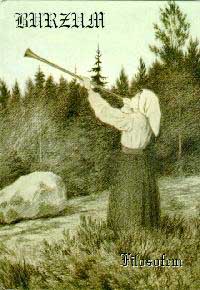
Production: Clear but less obscure and fundamental; a thinner sound, especially in the reediness of the guitar. Keyboards are more clearly separated from the guitar than previously. (Editor's note: This album was mixed/produced while Varg was in prison, and he has never heard its final form.)
Review: Both evolving to simplicity and devolving to pop music, Burzum produces a troublingly obscure and romantic work. Some call it "Odinpop" but Europop might more accurately reflect the roots of the new aesthetic, which resembles the culture of the self-destructive tormented artist self who puts forth simple, corruptedly cryptic messages of angst.
The rhythms are simple percussive matrices underlying simple phrase beats played in the cutting distortion of the guitar, the combination of percussion and duration that reveals the components of each note and chord simultaneously. With a flexible strumming technique that smears a distorted flow of notes into chords and melodies, hypnotizing with sound in the simplest components of a song that builds a mood from the ambiguity of the melodic recombinance of the musical space that emerges. Strobing, pulsing, living music radiates from these simple, definitive riffs.
Ambiguity enlists the help of the duality of guitar; the percussive broad strokes of rhythm are kept solid on beat here while the swarming chaos of anarchistic harmony provides a melancholic background of potential desire. Anonymous artisans like satyrs flow in the overwhelming flood of this guitar, so structural pop music on the surface and so corrupted and hopeless, indeterminate beneath.
1. Dunkelheit
2. Jesus' Tod 
3. Erblicket die Töchter des Firmaments
4. Gebrechlichkeit .I.
5. Rundgang um die transzendentale Säule der Singularität 
6. Gebrechlichkeit .II. 
Length: 64:36
|
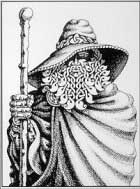
|
Emotion comes from the rasping voice distorted to merge with the electronic organic mass of sound, rhythmically adept to insert the contortions of speech in anguished, hopeless ferocity. There are cheeseball moments of this genre combination; the angstful-adolescent chantsinging choked with emotion would have inspired Nietzsche to vomit, sometimes the simplicity is overbearing: predictability of simple note combinations irritates some and comforts others.
But all of these are distortion knobs that the artist uses sometimes clumsily for great effect, spreading his stories across component patterns of a distant abstract view of existence as a passage of death: without context, they spin isolate melancholy tales of pain at not at this world but the acceptance of the world by others in numb repression.
There are three songs of pop-style black metal, then an ambient noise song separated by a 25-minute ambient keyboard track of astounding simplicity and relative profundity. Not as cutting, destructive, and angry as earlier releases it seems more reflective and nihilistic, recognizing prison as an indifferent destiny in a world this repulsively stupid.
|
Balder's Dod
Misanthropy
|
1997
|
|
|
Production: Direct transfer from digital sequencing keyboard allows sound to exist in abstract space of algorithmic tones and perfect silence.
Review: An extension of the minimalistic atonal symphonies which layered basic tone progressions over each other in fugues of masterful narrative layout, approaching a more complex ideal of song structure and its influence on the elements of the song, "Balder's Dod" constrains the pop-like melodic tendencies of the previous Burzum album to classically-inspired ambient looping structures, with less emphasis on overlay and harmonization as on sheer mutation of riff, song, and structure alike.
Often reusing familiar themes from "Filosofem," the evil Count Grishnack manipulates a traveling show of ancient delights in a narrative winding its way through dark emotions best described as harmonizations to a fantasy conceived in a dream. Obscurity reigns in the simple anti-riff patterns that fulfill the demand of a single-note lead for a constantly engaging melodic tension with tone sequences modifying themselves in subtle but structurally significant ways, throwing doubt on the structure and giving it the romantic requisite of dual nature and emotional wanderlust. Where in Plato's cave one saw silhouettes, in Grishnack's castle the light is hidden under shadow.
The repetitive nature of "Balder's Dod," and the frequent lack of percussion instruments, makes it a difficult chew for modern listeners, especially those expecting metal. Musically however these works continue the explorations of the dark Count in ways perhaps more profound than "Filosofem," which stagnated into wistful, almost drunkenly poignant pop music; here there is a new austerity of persona in the malevolent and brooding soul of nature restless in the presence of sleeping humanity.
|
Hlidskjalf
Misanthropy
|
1999
|
|
|
Production: This release being digital, there's not much to say here.
Review: Continuing his path of development, Count Grishnack's Burzum accelerates its growth to a form of mellow but highly significant "ambient soundscape" music that must be understood at an abstract level to appreciate its real beauty.
Burzum has evolved from raw black metal to an atmospheric style of classical music that reflects powerful concept and design in an executation that is a cliche of sound, a space best left to Mortiis and other professional cheeseballs.
Its sound: entirely machine, keyboards sequenced together with minimal percussion and rarely played in a "lead" role. Ambient long tempo structures and hypnotic pulsations of rhythm put this album in a dominant background role to your attention span, as if it were a soundtrack or sequence of demonic commands.
Underneath the lush skin of melodic layers comprising this music is once again the product of a highly refined musical thinker crafting distinctive works that speak the uniqueness and complexity of a situation or mood. Despite layered construction, this music is ultra-minimalistic: like Bach, many small pieces, recombinant versions of each other, interact to form a complex style and overall architecture.
In a similar error to that of Emperor's "Anthems to the Welkin at Dusk," there is an intrusion of narrative style to the music itself - something most recognize as condescending - as well the execution, which contains affectations of instrumental style and production production that are "old-sounding" to any trained ears.
These do not detract from the importance of the album, however: it as a whole is an advancing spiritual concept in music with many surprises to come. Classical in thematic architecture and concept, "Hlidskjalf" wears the surface of ambient soundscape while its muscles are raw, intense, nihilistic concepts in music.
|
BLACK | DEATH | HEAVY | SPEED | THRASH | GRINDCORE
Copyright © 1988-2004 the Dark Legions Archive
|
 In a search for what black metal would become it became necessary to find out what it meant, and that leads us to a category of black metal bands who are "the conceptualizers," most notably, Burzum,
In a search for what black metal would become it became necessary to find out what it meant, and that leads us to a category of black metal bands who are "the conceptualizers," most notably, Burzum,  While unorthodox to the tastes of the public, these political beliefs must be understood for the complex ideological system they express at the approach of the demise of a materialist civilization. In postmodernist thought, we learned that our society operates with a justified "text" of ostensible motivation, and a submlimated "subtext" of desires and natural passions. As society continues to crumble toward moralism in the midst of self-destruction, newer thinkers look away from Judeo-Christianity and Liberalism toward older modes of thought which valued the place of all of humanity in nature before the "moral worth" of the individual.
While unorthodox to the tastes of the public, these political beliefs must be understood for the complex ideological system they express at the approach of the demise of a materialist civilization. In postmodernist thought, we learned that our society operates with a justified "text" of ostensible motivation, and a submlimated "subtext" of desires and natural passions. As society continues to crumble toward moralism in the midst of self-destruction, newer thinkers look away from Judeo-Christianity and Liberalism toward older modes of thought which valued the place of all of humanity in nature before the "moral worth" of the individual.

